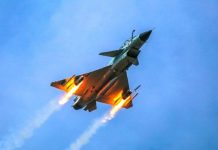Iran has reportedly fired its enigmatic Azarakhsh missile, which is believed to be a clone of the American-made AIM-9 Sidewinder missile, from one of its drones during a recently-held war drill.
Will Donald Trump Go Down In History As The Worst US President Ever?
Video footage of the war games shows the Iranian military using its Karrar drone to launch the Azarakhsh missile. Earlier, there were reports that Azarakhsh was a combination of an anti-tank and a short-range surface-to-air missile.
There were visuals of how the missile was launched from the belly of the Karrar “interceptor drone”, which had taken off from a truck-mounted launcher.
According to reports, the Islamic Republic of Iran’s Air Defense Force used the drones to bring down the hypothetical aerial target on the second day of the exercise. It was the first time that the missiles were used in any drill.

Military spokesperson, Rear Admiral Mahmoud Mousavi, said that the drills involving drones were aimed at creating a strong defense mechanism at the nation’s borders.
“Today, the borders are being carefully monitored and observed by the Army via drones equipped with surveillance and electronic information systems,” he said.
“Today, the Islamic Republic of Iran’s Army is capable of giving a strong response to any aggression by the enemy,” said Mousavi.
The Azarakhsh (thunderbolt) missile reportedly weighs around 155 pounds. According to the Islamic Revolutionary Guard Corps (IRGC), the missile is approximately 122 inches long, has a top speed of 1,230 miles per hour, and a range of just greater than 6 miles.
While the exact nature of the missile still remains a mystery, experts believe it to be a derivative of the US-made AIM-9 Sidewinder air-to-air missile.

The AIM-9 Sidewinder is a short-range air-to-air missile that was inducted into the United States Navy in 1956 and was subsequently adopted by the US Air Force in 1964.
It stands as the most widely used air-to-air missile in the West, with more than 110,000 missiles produced for the US and 27 other nations. Thousands of these missiles had earlier been delivered to Iran before the revolution that ousted the Shah in 1979.
Contrary to the suggestion of the missiles being adapted to drones under the drills, the IRGC had earlier described the missiles as weapons for helicopters and ground-based launchers.
According to reports, the targets used in the drills were said to have “low radar cross-section”, however, no further information was provided regarding it.
First revealed in 2010, the Karrar unmanned aerial vehicle was produced by the Iran Aircraft Manufacturing Industrial Company. The drone has a maximum range of around 620 miles, and is launched using a rocket booster, and can be recovered by a parachute.
The latest exercise highlighted the version of the Karrar drone which appeared to be fitted with an infrared sensor in the nose. While its function was not completely clear, as per unconfirmed reports, it converts the drone into a “suicide interceptor”, which helps it to destroy an aerial target like a heat-seeking missile.
Last year, in a similar fashion to the current Iranian drill, Russia’s Okhotnik unmanned combat air vehicle (UCAV), was reportedly flight-tested with air-to-air missiles for the first time.
However, unlike the Iranian drill, no weapons were actually launched from the drone.
Follow EurAsian Times on Google News




